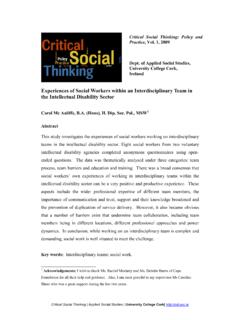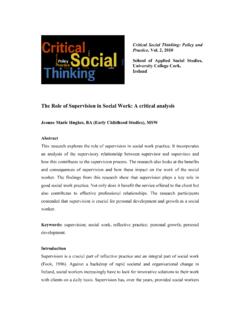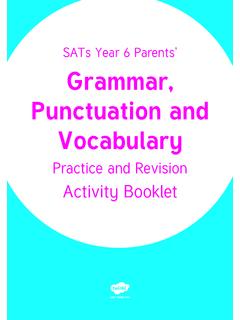Transcription of REPORT WRITING - University College Cork
1 1 | P a g e REPORT WRITING _____ What is REPORT WRITING ? This form of WRITING is used in the general and social sciences, as well as business, so to be able to compile a good REPORT is a very transferable academic skill. A REPORT is written with a clear purpose and for a specific audience and, as with all types of academic WRITING , clarity and conciseness is key. Before you begin your REPORT WRITING exercise, ensure that you are aware of any specific guidelines contained in your brief and also ensure that you use headings to guide your reader as you move from section to section.
2 TOP TIP All sources used in your analysis must be acknowledged and referenced throughout your REPORT ! WRITING the REPORT : where do I start? TOP TIP Planning and preparing your REPORT is key. You should decide on a clear structure before you begin to write the REPORT and that will make the process much easier for you. As with all types of academic WRITING , reports should be clear and concise. While the main areas to consider in REPORT WRITING are described below, do remember that the first draft of any written assignment should not be the one that is submitted, and it is vital that you leave adequate time for editing and proofreading.
3 Understand the brief The most important step is to unpack the brief you have been given and ensure you understand exactly what the purpose of your REPORT is to be. - Who are you WRITING this REPORT for, and why? 2 | P a g e - Do you understand all of the directions you are being given regarding this assignment brief? If not, refer directly to your lecturer/tutor for clarification. Compiling information Think about where you might source the required information. This may come from a vari-ety of sources, but how much information you will need is dictated by the degree of detail required in the REPORT .
4 Reading relevant general literature is a good place to begin your research, and you can then focus on more specific forms of data-gathering such as surveys, questionnaires, etc. TOP TIP Remember to refer constantly to the REPORT brief and ask yourself, if and how the information will fit into your REPORT . Organising material Once you have gathered your information you need to decide what is relevant and how you will present it. Firstly, group together points that are related within specific sections or chapters.
5 Your material should be ordered in a logical and coherent way throughout the REPORT , so be ready to cut out any irrelevant material. Analysing material It is not enough to just present the data and information you have gathered; you must an-alyse it and apply it according to the issue outlined in your REPORT brief. So, once you have decided on what is relevant material for your REPORT , ask yourself the following: - What conclusions can be drawn from the material? - What are the limitations of or flaws in the evidence? - Do certain pieces of evidence conflict with one another?
6 It is not enough to simply present the information you have gathered; you must relate it to the problem or issue described in the REPORT brief. 3 | P a g e The first draft .. So, you have gathered your material and organised it into appropriate sections: now what? Write concisely and clearly and directly make your points (do not leave room for con-fusion). Structure your paragraphs, sections and chapters as clearly as possible using the format below as a guide. TOP TIP You may find it easier to write the summary and contents page at the end when you know exactly what will be included.
7 - Introduce main idea of the paragraph/section/chapter. - Explain and develop this idea, clearly defining any key terms. - Present relevant evidence to support your point(s). - Comment on each piece of evidence as you show how it directly relates to these point(s). - Conclude the paragraph/section/chapter by either showing its significance to the REPORT as a whole, or making a link to the next para-graph/section/chapter. Reviewing, editing and redrafting TOP TIP Ideally, you should leave time between finishing the WRITING of your first draft and reviewing it: fresh eyes will catch more errors and omissions, than tired ones.
8 Review it from the perspective if the reader while asking yourself: - Is it easy to follow? - Is there a clear and logical structure? - Are the points clearly explained and supported by relevant evidence? - Is the relevance of my findings clear at each stage of my analysis? Expect to make several amendments at this stage because, as mentioned before, the first draft is not the one which should be submitted for that very reason! 4 | P a g e TOP TIP Organise your time properly: start early and make sure you have enough time to review and edit your REPORT prior to submission!
9 Proofreading Once you are satisfied with the content and structure of your redrafted REPORT , you can turn your attention to proofreading the REPORT and to its presentation. Always refer to the de-partmental guidelines included in your REPORT brief, regarding the format and presentation. 1. Check that the wording of each chapter/section/subheading is clear and accu-rate. 2. Check for consistency in numbering of chapters, sections and appendices. 3. Ensure that all your sources are acknowledged and correctly referenced. TOP TIP Proofread your REPORT for spelling , grammar and punctuation errors, which all create a poor impression and can make the REPORT difficult to read and can also cost you marks.
10 REPORT structure Title Page This should briefly describe the purpose of the REPORT (if this is not obvious from the title of the work). You may also include your name, the date and for whom the REPORT is written. Terms of Reference Depending on the subject matter, it is possible to give a brief explanation of why this re-port was written, the audience it is intended for and the methodology used to com-pile it. It may be in the form of a subtitle or a single paragraph. Summary This is a brief description of the REPORT content.








